Preprints
2025
-
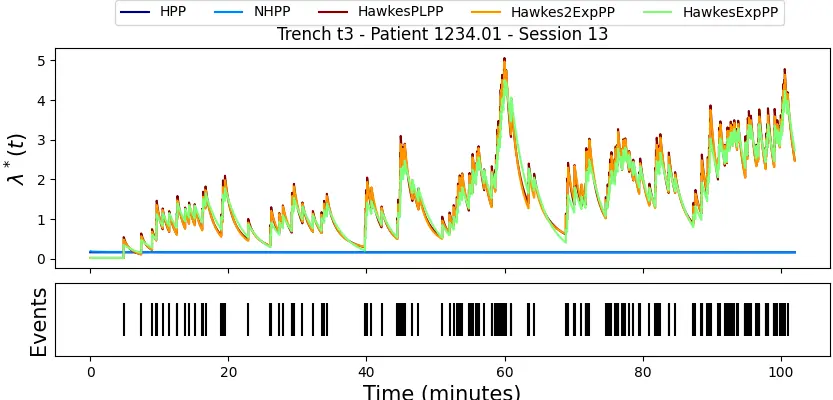 Temporal Point Process Modeling of Aggressive Behavior Onset in Psychiatric Inpatient Youths with AutismUnder review NPJMichael Potter, Michael Everett, Ashutosh Singh, and 6 more authorsNature Scientifc Reports, 2025
Temporal Point Process Modeling of Aggressive Behavior Onset in Psychiatric Inpatient Youths with AutismUnder review NPJMichael Potter, Michael Everett, Ashutosh Singh, and 6 more authorsNature Scientifc Reports, 2025Aggressive behavior, including aggression towards others and self-injury, occurs in up to 80% of children and adolescents with autism, making it a leading cause of behavioral health referrals and a major driver of healthcare costs. Predicting when autistic youth will exhibit aggression is challenging due to their communication difficulties. Many are minimally verbal or have poor emotional insight. Recent advances in Machine Learning and wearable biosensing enable short-term aggression predictions within a limited future window (typically one to three minutes). However, existing models do not estimate aggression probability within longer future windows nor the expected number of aggression onsets over such a period. To address these limitations, we employ Temporal Point Processes (TPPs) to model the generative process of aggressive behavior onsets in inpatient youths with autism. We hypothesize that aggressive behavior onsets follow a self-exciting process driven by short-term history, making them well-suited for Hawkes Point Process modeling. We establish a benchmark and demonstrate through Goodness-of-Fit statistics and predictive metrics that TPPs perform well modeling aggressive behavior onsets in inpatient youths with autism. Additionally, we gain insights into the onset generative process, like the branching factor near criticality, and suggest TPPs may enhance future clinical decision-making and preemptive interventions.
-
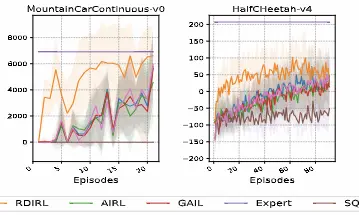 Recursive Deep Inverse Reinforcement LearningUnder review NIPSPaul Ghanem, Michael Potter, Owen Howell, and 4 more authorsThe Thirty-Ninth Annual Conference on Neural Information Processing Systems, 2025
Recursive Deep Inverse Reinforcement LearningUnder review NIPSPaul Ghanem, Michael Potter, Owen Howell, and 4 more authorsThe Thirty-Ninth Annual Conference on Neural Information Processing Systems, 2025Inferring an adversary’s goals from exhibited behavior is crucial for counterplanning and non-cooperative multi-agent systems in domains like cybersecurity, military, and strategy games. Deep Inverse Reinforcement Learning (IRL) methods based on maximum entropy principles show promise in recovering adversaries’ goals but are typically offline, require large batch sizes with gradient descent, and rely on first-order updates, limiting their applicability in real-time scenarios. We propose an online Recursive Deep Inverse Reinforcement Learning (RDIRL) approach to recover the cost function governing the adversary actions and goals. Specifically, we minimize an upper bound on the standard Guided Cost Learning (GCL) objective using sequential second-order Newton updates, akin to the Extended Kalman Filter (EKF), leading to a fast (in terms of convergence) learning algorithm. We demonstrate that RDIRL is able to recover cost and reward functions of expert agents in standard and adversarial benchmark tasks. Experiments on benchmark tasks show that our proposed approach outperforms several leading IRL algorithms.
-
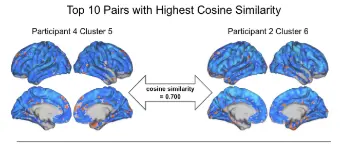 Exploring Theory-Laden Observations in the Brain Basis of Emotional ExperienceUnder review TBDChristiana Westlin*, Ashutosh Singh*, Deniz Erdogmus, and 2 more authorsTBD, 2025
Exploring Theory-Laden Observations in the Brain Basis of Emotional ExperienceUnder review TBDChristiana Westlin*, Ashutosh Singh*, Deniz Erdogmus, and 2 more authorsTBD, 2025In the science of emotion, it is widely assumed that folk emotion categories form a biological and psychological typology, and studies are routinely designed and analyzed to identify emotion-specific patterns. This approach shapes the observations that studies report, ultimately reinforcing the assumption that guided the investigation. Here, we reanalyzed data from one such typologically-guided study that reported mappings between individual brain patterns and group-averaged ratings of 34 emotion categories. Our reanalysis was guided by an alternative view of emotion categories as populations of variable, situated instances, and which predicts a priori that there will be significant variation in brain patterns within a category across instances. Correspondingly, our analysis made minimal assumptions about the structure of the variance present in the data. As predicted, we did not observe the original mappings and instead observed significant variation across individuals. These findings demonstrate how starting assumptions can ultimately impact scientific conclusions and suggest that a hypothesis must be supported using multiple analytic methods before it is taken seriously.
2023
-
 Tubular Curvature Filter: Implicit Pointwise Curvature Calculation Method for Tubular ObjectsUnder review TMRElifnur Sunger, Beyza Kalkanli, Veysi Yildiz, and 3 more authorsarXiv preprint arXiv:2311.11931, 2023
Tubular Curvature Filter: Implicit Pointwise Curvature Calculation Method for Tubular ObjectsUnder review TMRElifnur Sunger, Beyza Kalkanli, Veysi Yildiz, and 3 more authorsarXiv preprint arXiv:2311.11931, 2023Curvature estimation methods are important as they capture salient features for various applications in image processing, especially within medical domains where tortuosity of vascular structures is of significant interest. Existing methods based on centerline or skeleton curvature fail to capture curvature gradients across a rotating tubular structure. This paper presents a Tubular Curvature Filter method that locally calculates the acceleration of bundles of curves that traverse along the tubular object parallel to the centerline. This is achieved by examining the directional rate of change in the eigenvectors of the Hessian matrix of a tubular intensity function in space. This method implicitly calculates the local tubular curvature without the need to explicitly segment the tubular object. Experimental results demonstrate that the Tubular Curvature Filter method provides accurate estimates of local curvature at any point inside tubular structures.
Published
2025
-
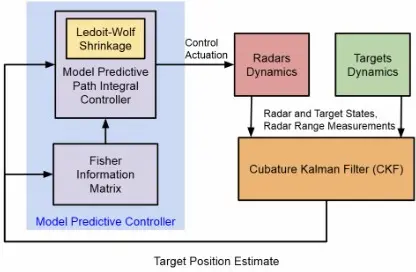 Continuously Optimizing Radar Placement with Model Predictive Path IntegralsPublished TAESMichael Potter, Shuo Tang, Paul Ghanem, and 8 more authors2025
Continuously Optimizing Radar Placement with Model Predictive Path IntegralsPublished TAESMichael Potter, Shuo Tang, Paul Ghanem, and 8 more authors2025Continuously optimizing sensor placement is essential for precise target localization in various military and civilian applications. While information theory has shown promise in optimizing sensor placement, many studies oversimplify sensor measurement models or neglect dynamic constraints of mobile sensors. To address these challenges, we employ a range measurement model that incorporates radar parameters and radar-target distance, coupled with Model Predictive Path Integral (MPPI) control to manage complex environmental obstacles and dynamic constraints. We compare the proposed approach against stationary radars or simplified range measurement models based on the root mean squared error (RMSE) of the Cubature Kalman Filter (CKF) estimator for the targets’ state. Additionally, we visualize the evolving geometry of radars and targets over time, highlighting areas of highest measurement information gain, demonstrating the strengths of the approach. The proposed strategy outperforms stationary radars and simplified range measurement models in target localization, achieving a 38-74% reduction in mean RMSE and a 33-79% reduction in the upper tail of the 90% Highest Density Interval (HDI) over 500 Monte Carl (MC) trials across all time steps. Code will be made publicly available upon acceptance.
-
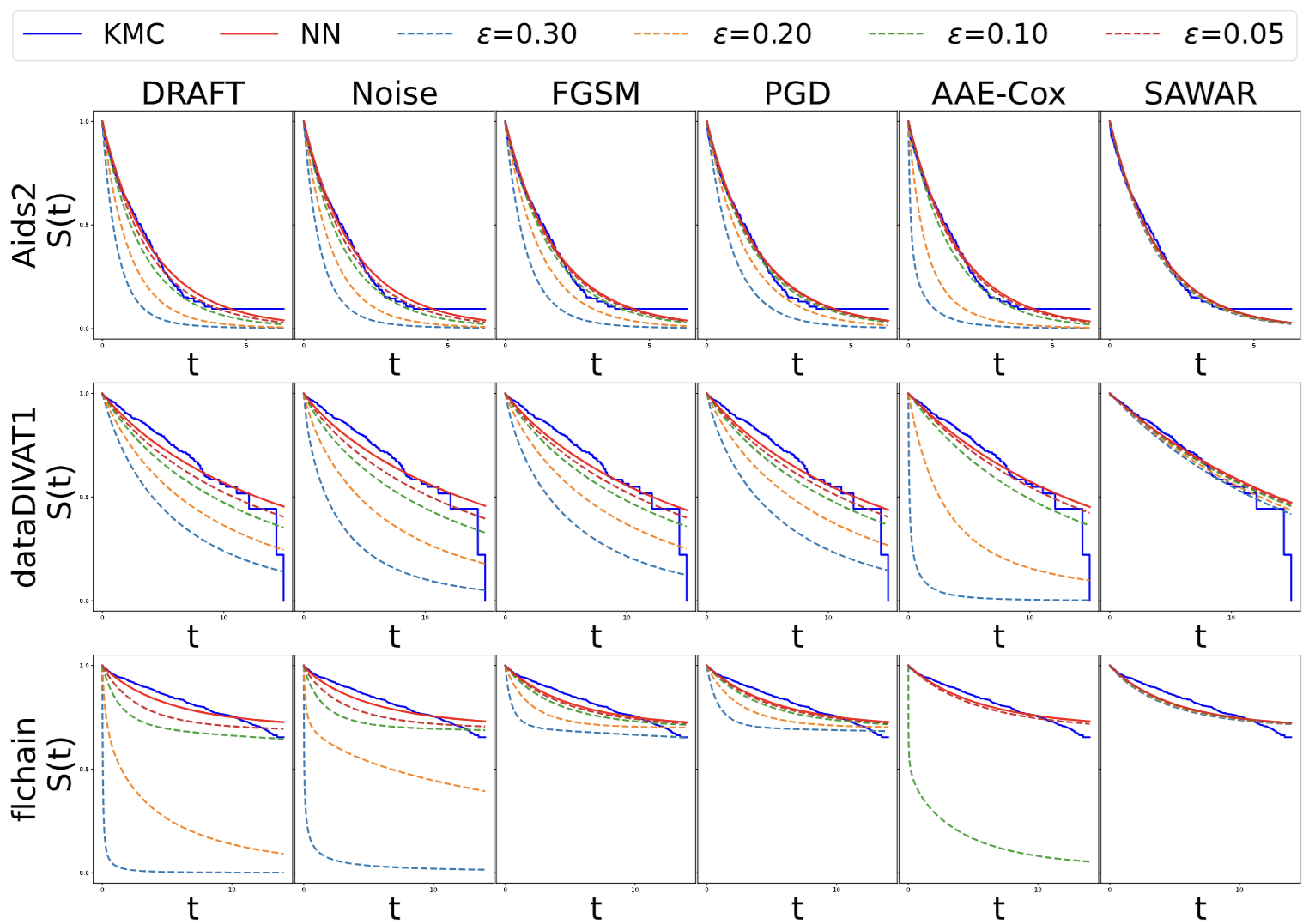 Robust Survival Analysis with Adversarial RegularizationPublished ICHIMichael Potter, Stefano Maxenti, and Michael EverettIEEE International Conference on Healthcare Informatics 2025, 2025
Robust Survival Analysis with Adversarial RegularizationPublished ICHIMichael Potter, Stefano Maxenti, and Michael EverettIEEE International Conference on Healthcare Informatics 2025, 2025Survival Analysis (SA) models the time until an event occurs, with applications in fields like medicine, defense, finance, and aerospace. Recent research indicates that Neural Networks (NNs) can effectively capture complex data patterns in SA, whereas simple generalized linear models often fall short in this regard. However, dataset uncertainties (e.g., noisy measurements, human error) can degrade NN model performance. To address this, we leverage advances in NN verification to develop training objectives for robust, fully-parametric SA models. Specifically, we propose an adversarially robust loss function based on a Min-Max optimization problem. We employ CROWN-Interval Bound Propagation (CROWN-IBP) to tackle the computational challenges inherent in solving this Min-Max problem. Evaluated over 10 SurvSet datasets, our method, Survival Analysis with Adversarial Regularization (SAWAR), consistently outperforms baseline adversarial training methods and state-of-the-art (SOTA) deep SA models across various covariate perturbations with respect to Negative Log Likelihood (NegLL), Integrated Brier Score (IBS), and Concordance Index (CI) metrics. Thus, we demonstrate that adversarial robustness enhances SA predictive performance and calibration, mitigating data uncertainty and improving generalization across diverse datasets by up to 150% compared to baselines.
-
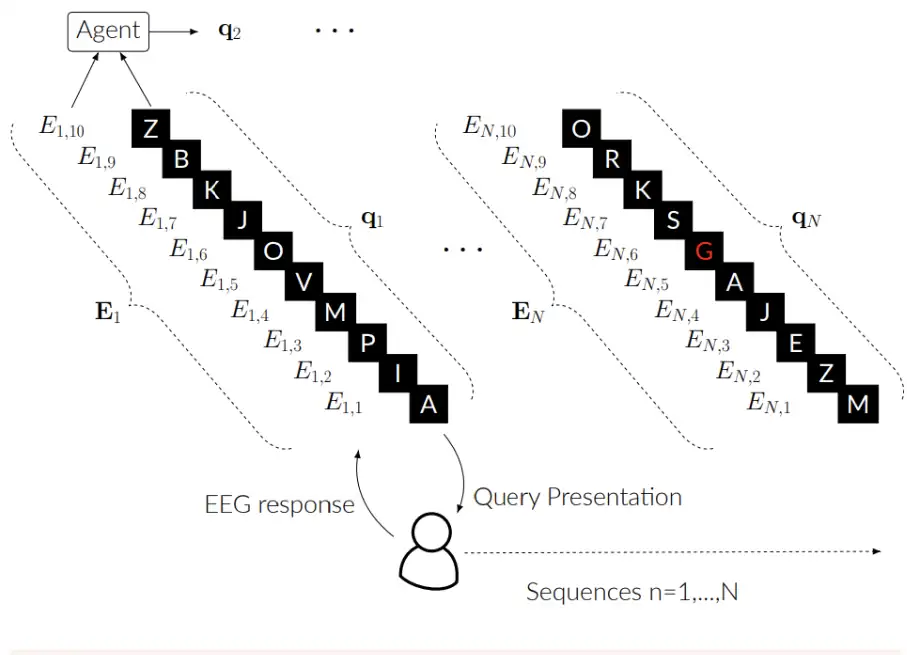 MarkovType: A Markov Decision Process Strategy for Non-Invasive Brain-Computer Interfaces Typing SystemsPublished AAAIElifnur Sunger, Yunus Bicer, Deniz Erdogmus, and 1 more authorThe 39th Annual AAAI Conference on Artificial Intelligence, 2025
MarkovType: A Markov Decision Process Strategy for Non-Invasive Brain-Computer Interfaces Typing SystemsPublished AAAIElifnur Sunger, Yunus Bicer, Deniz Erdogmus, and 1 more authorThe 39th Annual AAAI Conference on Artificial Intelligence, 2025Brain-Computer Interfaces (BCIs) help people with severe speech and motor disabilities communicate and interact with their environment using neural activity. This work focuses on the Rapid Serial Visual Presentation (RSVP) paradigm of BCIs using noninvasive electroencephalography (EEG). The RSVP typing task is a recursive task with multiple sequences, where users see only a subset of symbols in each sequence. Extensive research has been conducted to improve classification in the RSVP typing task, achieving fast classification. However, these methods struggle to achieve high accuracy and do not consider the typing mechanism in the learning procedure. They apply binary target and non-target classification without including recursive training. To improve performance in the classification of symbols while controlling the classification speed, we incorporate the typing setup into training by proposing a Partially Observable Markov Decision Process (POMDP) approach. To the best of our knowledge, this is the first work to formulate the RSVP typing task as a POMDP for recursive classification. Experiments show that the proposed approach, MarkovType, results in a more accurate typing system compared to competitors. Additionally, our experiments demonstrate that while there is a trade-off between accuracy and speed, MarkovType achieves the optimal balance between these factors compared to other methods.
-
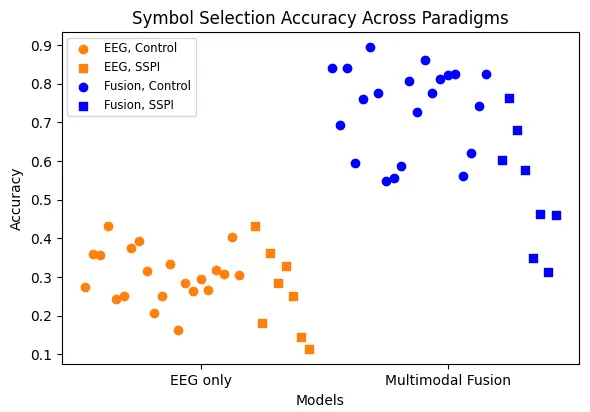 Multimodal Sensor Fusion for EEG-Based BCI Typing SystemsPublished BCI Soc.Basak Celik, Tab Memmott, Yorgos Stratis, and 5 more authors11th International BCI Meeting, 2025
Multimodal Sensor Fusion for EEG-Based BCI Typing SystemsPublished BCI Soc.Basak Celik, Tab Memmott, Yorgos Stratis, and 5 more authors11th International BCI Meeting, 2025For people with severe speech and physical impairments (SSPI), a robust communication interface is often a necessity to improve quality of life. Non-implantable electroencephalography (EEG)-based BCI typing systems are one option in the field to restore communication. In this work, we describe a multimodal fusion algorithm combining EEG and gaze tracking (i.e., fixation and trajectory) for control of an ERP-based BCI. This work focuses on a specific BCI paradigm called single-character-presentation (SCP) based visual presentation, which consists of symbols presented in matrix form and individually highlighted in randomized order. We develop and compare probabilistic Bayesian fusion algorithms of increasing complexity to observe the effect of probabilistic assumption sets on the multimodal BCI performance. We propose a method assuming positional and temporal dependence in gaze evidence. Experiments with both control participants and people with SSPI show that the proposed multimodal Bayesian fusion method significantly improves performance in symbol selection. Code is publicly available at https://github.com/CAMBI-tech/BciPy.
-
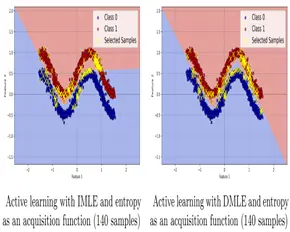 Dependency-Aware Maximum Likelihood Estimation for Active LearningPublished TMLRBeyza Kalkanli, Tales Imbiriba, Stratis Ioannidis, and 2 more authorsTransactions on Machine Learning Research, 2025
Dependency-Aware Maximum Likelihood Estimation for Active LearningPublished TMLRBeyza Kalkanli, Tales Imbiriba, Stratis Ioannidis, and 2 more authorsTransactions on Machine Learning Research, 2025Active learning aims to efficiently build a labeled training set by strategically selecting samples to query labels from annotators. In this sequential process, each sample acquisition influences subsequent selections, causing dependencies among samples in the labeled set. However, these dependencies are overlooked during the model parameter estimation stage when updating the model using Maximum Likelihood Estimation (MLE), a conventional method that assumes independent and identically distributed (i.i.d.) data. We propose Dependency-aware MLE (DMLE), which corrects MLE within the active learning framework by addressing sample dependencies typically neglected due to the i.i.d. assumption, ensuring consistency with active learning principles in the model parameter estimation process. This improved method achieves superior performance across multiple benchmark datasets, reaching higher performance in earlier cycles compared to conventional MLE. Specifically, we observe average accuracy improvements of 6%, 8.6%, and 10.5% for k=1, k=5, and k=10 respectively, after collecting the first 100 samples, where entropy is the acquisition function and k is the query batch size acquired at every active learning cycle.
-
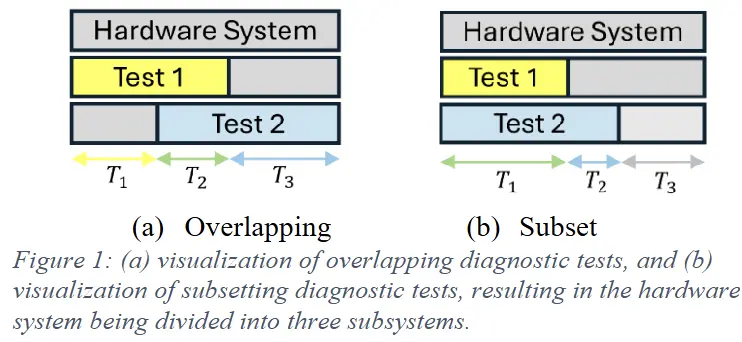 Active Learning For Repairable Hardware Systems With Partial CoveragePublished RAMSMichael Potter, Beyza Kalkanlı, Deniz Erdoğmuş, and 1 more authorIEEE Reliability and Maintainability Symposium - Europe, 2025
Active Learning For Repairable Hardware Systems With Partial CoveragePublished RAMSMichael Potter, Beyza Kalkanlı, Deniz Erdoğmuş, and 1 more authorIEEE Reliability and Maintainability Symposium - Europe, 2025Identifying the optimal diagnostic test and hardware system instance to infer reliability characteristics using field data is challenging, especially when constrained by fixed budgets and minimal maintenance cycles. Active Learning (AL) has shown promise for parameter inference with limited data and budget constraints in machine learning/deep learning tasks. However, AL for reliability model parameter inference remains underexplored for repairable hardware systems. It requires specialized AL Acquisition Functions (AFs) that consider hardware aging and the fact that a hardware system consists of multiple sub-systems, which may undergo only partial testing during a given diagnostic test. To address these challenges, we propose a relaxed Mixed Integer Semidefinite Program (MISDP) AL AF that incorporates Diagnostic Coverage (DC), Fisher Information Matrices (FIMs), and diagnostic testing budgets. Furthermore, we design empirical-based simulation experiments focusing on two diagnostic testing scenarios: (1) partial tests of a hardware system with overlapping subsystem coverage, and (2) partial tests where one diagnostic test fully subsumes the subsystem coverage of another. We evaluate our proposed approach against the most widely used AL AF in the literature (entropy), as well as several intuitive AL AFs tailored for reliability model parameter inference. Our proposed AF ranked best on average among the alternative AFs across 6,000 experimental configurations, with respect to Area Under the Curve (AUC) of the Absolute Total Expected Event Error (ATEER) and Mean Squared Error (MSE) curves, with statistical significance calculated at a 0.05 alpha level using a Friedman hypothesis test.
-
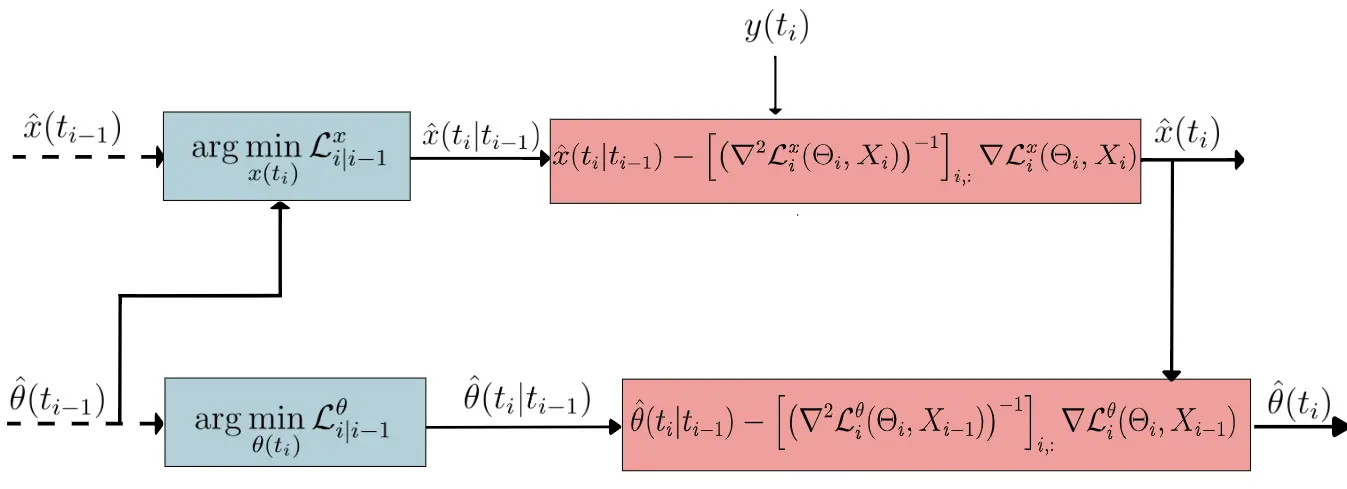 Learning Physics Informed Neural ODEs With Partial MeasurementsPublished AAAIPaul Ghanem, Ahmet Demirkaya, Tales Imbiriba, and 3 more authorsThe 39th Annual AAAI Conference on Artificial Intelligence, 2025
Learning Physics Informed Neural ODEs With Partial MeasurementsPublished AAAIPaul Ghanem, Ahmet Demirkaya, Tales Imbiriba, and 3 more authorsThe 39th Annual AAAI Conference on Artificial Intelligence, 2025Learning dynamics governing physical and spatiotemporal processes is a challenging problem, especially in scenarios where states are partially measured. In this work, we tackle the problem of learning dynamics governing these systems when parts of the system’s states are not measured, specifically when the dynamics generating the non-measured states are unknown. Inspired by state estimation theory and Physics Informed Neural ODEs, we present a sequential optimization framework in which dynamics governing unmeasured processes can be learned. We demonstrate the performance of the proposed approach leveraging numerical simulations and a real dataset extracted from an electro-mechanical positioning system. We show how the underlying equations fit into our formalism and demonstrate the improved performance of the proposed method when compared with baselines.
2024
-
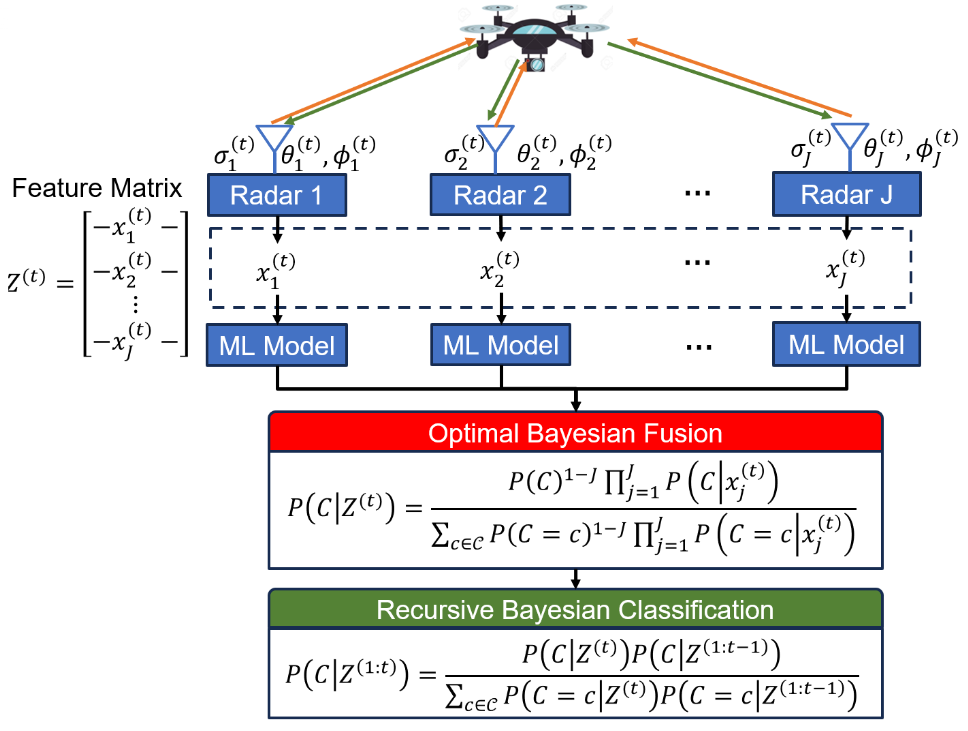 Multistatic-Radar RCS-Signature Recognition of Aerial Vehicles: A Bayesian Fusion ApproachPublished TAESMichael Potter, Murat Akcakaya, Marius Necsoiu, and 3 more authorsIEEE Transactions on Aerospace and Electronic Systems, 2024
Multistatic-Radar RCS-Signature Recognition of Aerial Vehicles: A Bayesian Fusion ApproachPublished TAESMichael Potter, Murat Akcakaya, Marius Necsoiu, and 3 more authorsIEEE Transactions on Aerospace and Electronic Systems, 2024Radar Automated Target Recognition (RATR) for Unmanned Aerial Vehicles (UAVs) involves transmitting Electromagnetic Waves (EMWs) and performing target type recognition on the received radar echo, which has important applications in defense and aerospace. Previous work has demonstrated the benefits of employing multistatic radar configurations in RATR compared to monostatic radar configurations. However, multistatic radar configurations commonly use fusion methods which combine the classification vectors of multiple individual radars suboptimally from a probabilistic perspective. To address this issue, this work leverages Bayesian analysis to provide a fully Bayesian RATR framework for UAV type classification. Specifically, we employ an Optimal Bayesian Fusion (OBF) method, from the Bayesian perspective of expected 0-1 loss, to formulate a posterior distribution that aggregates the classification probability vectors from multiple individual radar observations at a given time step. This OBF method is used to update a separate Recursive Bayesian Classification (RBC) posterior distribution on the target UAV type. The RBC posterior is conditioned on all historical observations made from multiple radars across multiple time steps. To evaluate the proposed approach, we simulate random walk trajectories for seven drones and correspond the target’s aspect angles to Radar Cross Section (RCS) measurements acquired in an anechoic chamber. We then compare the performance of single radar Automated Target Recognition (ATR) system and suboptimal fusion methods against the OBF method. We empirically show that the OBF method, integrated with RBC, significantly outperforms other fusion methods and single radar configuration in terms of classification accuracy.
-
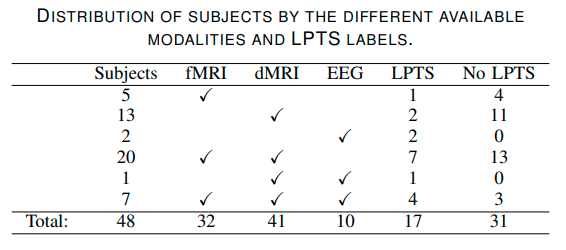 Advancing post-traumatic seizure classification and biomarker identification: Information decomposition based multimodal fusion and explainable machine learning with missing neuroimaging dataPublished CMIGMd Navid Akbar, Sebastian F Ruf, Ashutosh Singh, and 8 more authorsComputerized Medical Imaging and Graphics, 2024
Advancing post-traumatic seizure classification and biomarker identification: Information decomposition based multimodal fusion and explainable machine learning with missing neuroimaging dataPublished CMIGMd Navid Akbar, Sebastian F Ruf, Ashutosh Singh, and 8 more authorsComputerized Medical Imaging and Graphics, 2024A late post-traumatic seizure (LPTS), a consequence of traumatic brain injury (TBI), can potentially evolve into a lifelong condition known as post-traumatic epilepsy (PTE). Presently, the mechanism that triggers epileptogenesis in TBI patients remains elusive, inspiring the epilepsy community to devise ways to predict which TBI patients will develop PTE and to identify potential biomarkers. In response to this need, our study collected comprehensive, longitudinal multimodal data from 48 TBI patients across multiple participating institutions. A supervised binary classification task was created, contrasting data from LPTS patients with those without LPTS. To accommodate missing modalities in some subjects, we took a two-pronged approach. Firstly, we extended a graphical model-based Bayesian estimator to directly classify subjects with incomplete modality. Secondly, we explored conventional imputation techniques. The imputed multimodal information was then combined, following several fusion and dimensionality reduction techniques found in the literature, and subsequently fitted to a kernel- or a tree-based classifier. For this fusion, we proposed two new algorithms: recursive elimination of correlated components (RECC) that filters information based on the correlation between the already selected features, and information decomposition and selective fusion (IDSF), which effectively recombines information from decomposed multimodal features. Our cross-validation findings showed that the proposed IDSF algorithm delivers superior performance based on the area under the curve (AUC) score. Ultimately, after rigorous statistical comparisons and interpretable machine learning examination using Shapley values of the most frequently selected features, we recommend the two following magnetic resonance imaging (MRI) abnormalities as potential biomarkers: the left anterior limb of internal capsule in diffusion MRI (dMRI), and the right middle temporal gyrus in functional MRI (fMRI).
-
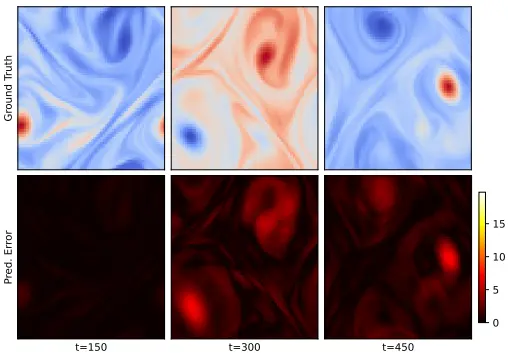 Learning Semilinear Neural Operators: A Unified Recursive Framework For Prediction And Data AssimilationPublished ICLRAshutosh Singh, Ricardo Augusto Borsoi, Deniz Erdogmus, and 1 more authorInternational Conference on Learning Representations, 2024
Learning Semilinear Neural Operators: A Unified Recursive Framework For Prediction And Data AssimilationPublished ICLRAshutosh Singh, Ricardo Augusto Borsoi, Deniz Erdogmus, and 1 more authorInternational Conference on Learning Representations, 2024Recent advances in the theory of Neural Operators (NOs) have enabled fast and accurate computation of the solutions to complex systems described by partial differential equations (PDEs). Despite their great success, current NO-based solutions face important challenges when dealing with spatio-temporal PDEs over long time scales. Specifically, the current theory of NOs does not present a systematic framework to perform data assimilation and efficiently correct the evolution of PDE solutions over time based on sparsely sampled noisy measurements. In this paper, we propose a learning-based state-space approach to compute the solution operators to infinite-dimensional semilinear PDEs. Exploiting the structure of semilinear PDEs and the theory of nonlinear observers in function spaces, we develop a flexible recursive method that allows for both prediction and data assimilation by combining prediction and correction operations. The proposed framework is capable of producing fast and accurate predictions over long time horizons, dealing with irregularly sampled noisy measurements to correct the solution, and benefits from the decoupling between the spatial and temporal dynamics of this class of PDEs. We show through experiments on the KuramotoSivashinsky, Navier-Stokes and Korteweg-de Vries equations that the proposed model is robust to noise and can leverage arbitrary amounts of measurements to correct its prediction over a long time horizon with little computational overhead.
-
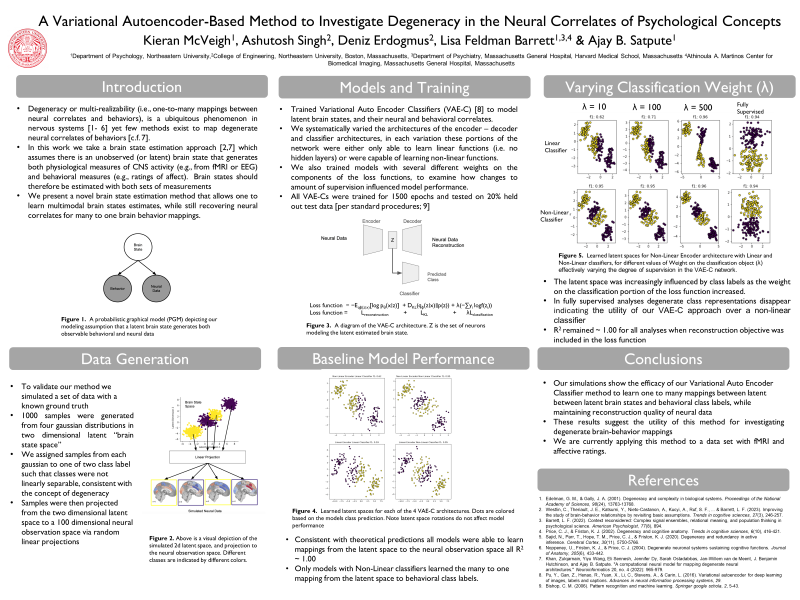 A Variational Autoencoder-Based Method to Investigate Degeneracy in the Neural Correlates of Psychological ConceptsPublished SANSKieran McVeigh, Ashutosh Singh, Deniz Erdogmus, and 2 more authorsSocial & Affective Neuroscience Society, 2024
A Variational Autoencoder-Based Method to Investigate Degeneracy in the Neural Correlates of Psychological ConceptsPublished SANSKieran McVeigh, Ashutosh Singh, Deniz Erdogmus, and 2 more authorsSocial & Affective Neuroscience Society, 2024 -
 User Training With Error Augmentation for sEMG-Based Gesture ClassificationPublished TNSREYunus Bicer, Niklas Smedemark-Margulies, Basak Celik, and 7 more authorsIEEE Transactions on Neural Systems and Rehabilitation Engineering, 2024
User Training With Error Augmentation for sEMG-Based Gesture ClassificationPublished TNSREYunus Bicer, Niklas Smedemark-Margulies, Basak Celik, and 7 more authorsIEEE Transactions on Neural Systems and Rehabilitation Engineering, 2024We designed and tested a system for real-time control of a user interface by extracting surface electromyographic (sEMG) activity from eight electrodes in a wristband configuration. sEMG data were streamed into a machine-learning algorithm that classified hand gestures in real-time. After an initial model calibration, participants were presented with one of three types of feedback during a human-learning stage: veridical feedback, in which predicted probabilities from the gesture classification algorithm were displayed without alteration; modified feedback, in which we applied a hidden augmentation of error to these probabilities; and no feedback. User performance was then evaluated in a series of minigames, in which subjects were required to use eight gestures to manipulate their game avatar to complete a task. Experimental results indicated that relative to the baseline, the modified feedback condition led to significantly improved accuracy. Class separation also improved, though this trend was not significant. These findings suggest that real-time feedback in a gamified user interface with manipulation of feedback may enable intuitive, rapid, and accurate task acquisition for sEMG-based gesture recognition applications.
-
 Fast and Expressive Gesture Recognition using a Combination-Homomorphic Electromyogram EncoderPublished TMLRNiklas Smedemark-Margulies, Yunus Bicer, Elifnur Sunger, and 5 more authorsTransactions on Machine Learning Research, 2024
Fast and Expressive Gesture Recognition using a Combination-Homomorphic Electromyogram EncoderPublished TMLRNiklas Smedemark-Margulies, Yunus Bicer, Elifnur Sunger, and 5 more authorsTransactions on Machine Learning Research, 2024We study the task of gesture recognition from electromyography (EMG), with the goal of enabling expressive human-computer interaction at high accuracy, while minimizing the time required for new subjects to provide calibration data. To fulfill these goals, we define combination gestures consisting of a direction component and a modifier component. New subjects only demonstrate the single component gestures and we seek to extrapolate from these to all possible single or combination gestures. We extrapolate to unseen combination gestures by combining the feature vectors of real single gestures to produce synthetic training data. This strategy allows us to provide a large and flexible gesture vocabulary, while not requiring new subjects to demonstrate combinatorially many example gestures. We pre-train an encoder and a combination operator using self-supervision, so that we can produce useful synthetic training data for unseen test subjects. To evaluate the proposed method, we collect and release a real-world EMG dataset, and measure the effect of augmented supervision against two baselines: a partially-supervised model trained with only single gesture data from the unseen subject, and a fully-supervised model trained with real single and real combination gesture data from the unseen subject. We find that the proposed method provides a dramatic improvement over the partially-supervised model, and achieves a useful classification accuracy that in some cases approaches the performance of the fully-supervised model.
2023
-
 Wearable biosensing to predict imminent aggressive behavior in psychiatric inpatient youths with autismPublished JAMATales Imbiriba, Ahmet Demirkaya, Ashutosh Singh, and 2 more authorsJAMA network open, 2023
Wearable biosensing to predict imminent aggressive behavior in psychiatric inpatient youths with autismPublished JAMATales Imbiriba, Ahmet Demirkaya, Ashutosh Singh, and 2 more authorsJAMA network open, 2023IMPORTANCE Aggressive behavior is a prevalent and challenging issue in individuals with autism. OBJECTIVE To investigate whether changes in peripheral physiology recorded by a wearable biosensor and machine learning can be used to predict imminent aggressive behavior before it occurs in inpatient youths with autism. DESIGN, SETTING, AND PARTICIPANTS This noninterventional prognostic study used data collected from March 2019 to March 2020 from 4 primary care psychiatric inpatient hospitals. Enrolled participants were 86 psychiatric inpatients with confirmed diagnoses of autism exhibiting operationally defined self-injurious behavior, emotion dysregulation, or aggression toward others; 16 individuals were not included (18.6%) because they would not wear the biosensor (8 individuals) or were discharged before an observation could be made (8 individuals). Data were analyzed from March 2020 through October 2023. MAIN OUTCOMES AND MEASURES Research staff performed live behavioral coding of aggressive behavior while inpatient study participants wore a commercially available biosensor that recorded peripheral physiological signals (cardiovascular activity, electrodermal activity, and motion). Logistic regression, support vector machines, neural networks, and domain adaptation were used to analyze time-series features extracted from biosensor data. Area under the receiver operating characteristic curve (AUROC) values were used to evaluate the performance of population- and persondependent models.
-
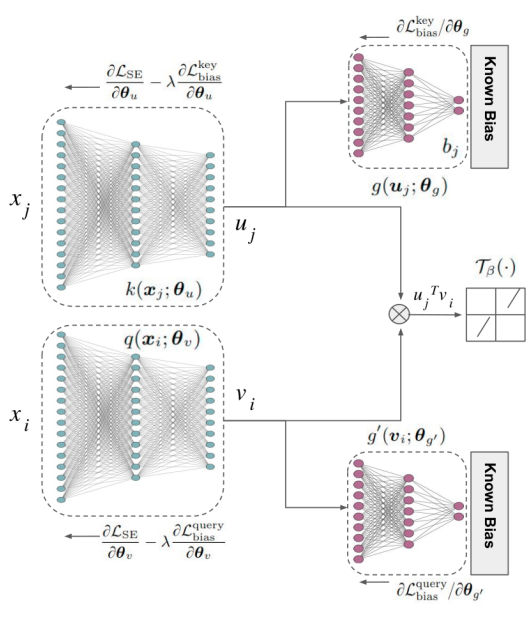 Inv-senet: Invariant self expression network for clustering under biased dataPublished ICASSPAshutosh Singh, Ashish Singh, Aria Masoomi, and 3 more authorsIn ICASSP 2023-2023 IEEE International Conference on Acoustics, Speech and Signal Processing (ICASSP), 2023
Inv-senet: Invariant self expression network for clustering under biased dataPublished ICASSPAshutosh Singh, Ashish Singh, Aria Masoomi, and 3 more authorsIn ICASSP 2023-2023 IEEE International Conference on Acoustics, Speech and Signal Processing (ICASSP), 2023Subspace clustering algorithms are used for understanding the cluster structure that explains the patterns prevalent in the dataset well. These methods are extensively used for data-exploration tasks in various areas of Natural Sciences. However, most of these methods fail to handle confounding attributes in the dataset. For datasets where a data sample represent multiple attributes, naively applying any clustering approach can result in undesired output. To this end, we propose a novel framework for jointly removing confounding attributes while learning to cluster data points in individual subspaces. Assuming we have label information about these confounding attributes, we regularize the clustering method by adversarially learning to minimize the mutual information between the data representation and the confounding attribute labels. Our experimental result on synthetic and real-world datasets demonstrate the effectiveness of our approach.
-
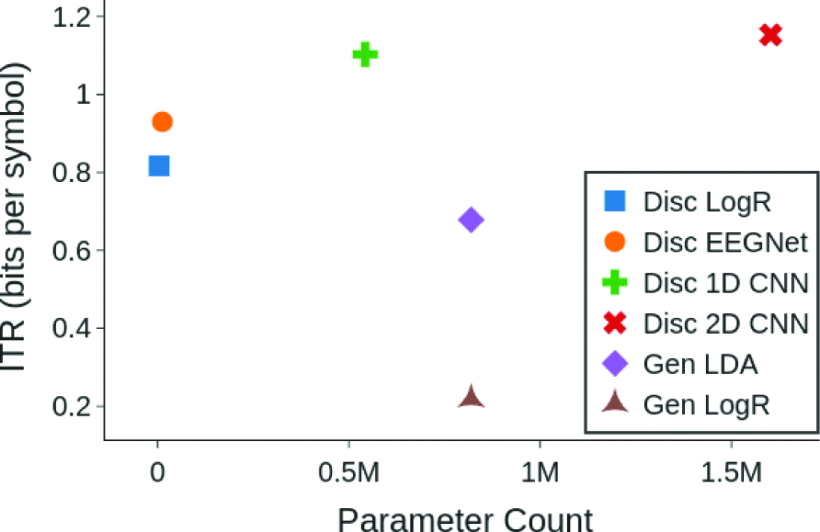 Recursive Estimation of User Intent From Noninvasive Electroencephalography Using Discriminative ModelsPublished ICASSPNiklas Smedemark-Margulies, Basak Celik, Tales Imbiriba, and 2 more authorsIn ICASSP 2023-2023 IEEE International Conference on Acoustics, Speech and Signal Processing (ICASSP), 2023
Recursive Estimation of User Intent From Noninvasive Electroencephalography Using Discriminative ModelsPublished ICASSPNiklas Smedemark-Margulies, Basak Celik, Tales Imbiriba, and 2 more authorsIn ICASSP 2023-2023 IEEE International Conference on Acoustics, Speech and Signal Processing (ICASSP), 2023We study the problem of inferring user intent from noninvasive electroencephalography (EEG) to restore communication for people with severe speech and physical impairments (SSPI). The focus of this work is improving the estimation of posterior symbol probabilities in a typing task. At each iteration of the typing procedure, a subset of symbols is chosen for the next query based on the current probability estimate. Evidence about the user’s response is collected from event-related potentials (ERP) in order to update symbol probabilities, until one symbol exceeds a predefined confidence threshold. We provide a graphical model describing this task, and derive a recursive Bayesian update rule based on a discriminative probability over label vectors for each query, which we approximate using a neural network classifier. We evaluate the proposed method in a simulated typing task and show that it outperforms previous approaches based on generative modeling.
2022
-
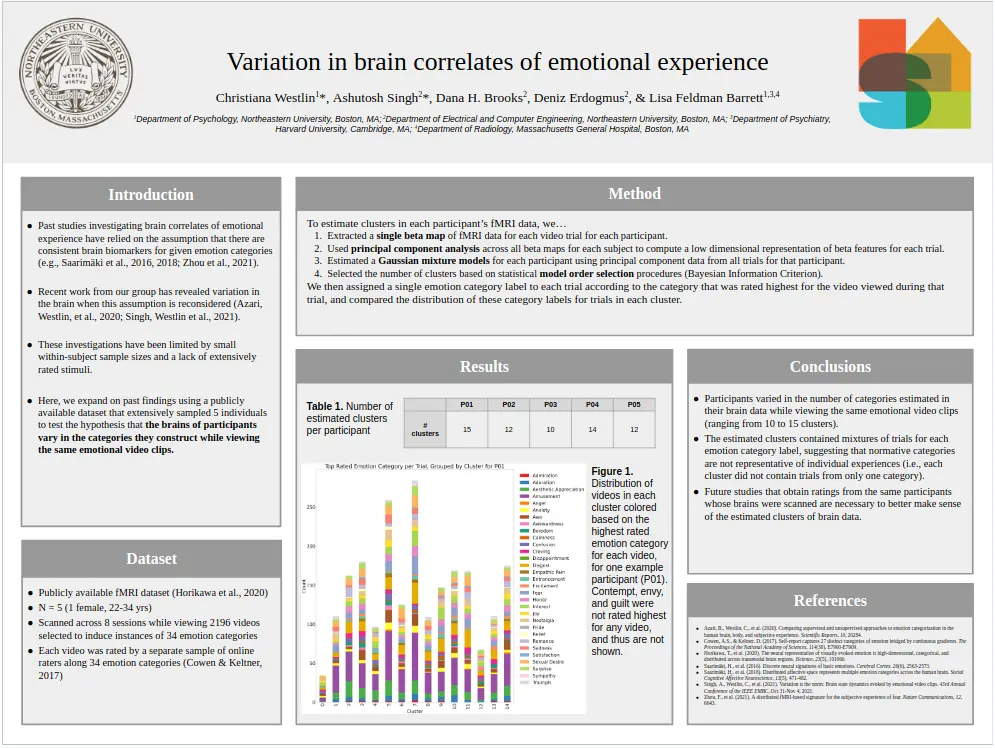 Variation in brain correlates of emotional experiencePublished SASChristiana Westlin*, Ashutosh Singh*, Dana H Brooks, and 2 more authorsIn Society for Affective Science Annual Conference, 2022
Variation in brain correlates of emotional experiencePublished SASChristiana Westlin*, Ashutosh Singh*, Dana H Brooks, and 2 more authorsIn Society for Affective Science Annual Conference, 2022For the last several decades, emotion research has attempted to identify a "biomarker" or consistent pattern of brain activity to characterize a single category of emotion (e.g., fear) that will remain consistent across all instances of that category, regardless of individual and context. In this study, we investigated variation rather than consistency during emotional experiences while people watched video clips chosen to evoke instances of specific emotion categories. Specifically, we developed a sequential probabilistic approach to model the temporal dynamics in a participant’s brain activity during video viewing. We characterized brain states during these clips as distinct state occupancy periods between state transitions in blood oxygen level dependent (BOLD) signal patterns. We found substantial variation in the state occupancy probability distributions across individuals watching the same video, supporting the hypothesis that when it comes to the brain correlates of emotional experience, variation may indeed be the norm.
-
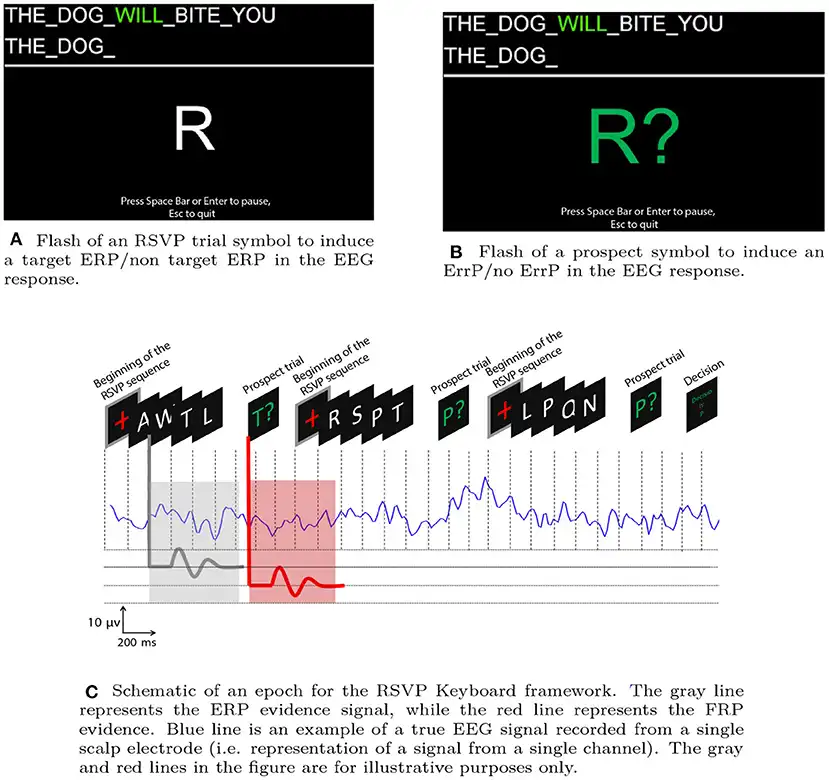 Feedback related potentials for EEG-based typing systemsPublished FHNPaula Gonzalez-Navarro, Basak Celik, Mohammad Moghadamfalahi, and 3 more authorsFrontiers in Human Neuroscience, 2022
Feedback related potentials for EEG-based typing systemsPublished FHNPaula Gonzalez-Navarro, Basak Celik, Mohammad Moghadamfalahi, and 3 more authorsFrontiers in Human Neuroscience, 2022Error related potentials (ErrP), which are elicited in the EEG in response to a perceived error, have been used for error correction and adaption in the event related potential (ERP)-based brain computer interfaces designed for typing. In these typing interfaces, ERP evidence is collected in response to a sequence of stimuli presented usually in the visual form and the intended user stimulus is probabilistically inferred (stimulus with highest probability) and presented to the user as the decision. If the inferred stimulus is incorrect, ErrP is expected to be elicited in the EEG. Early approaches to use ErrP in the design of typing interfaces attempt to make hard decisions on the perceived error such that the perceived error is corrected and either the sequence of stimuli are repeated to obtain further ERP evidence, or without further repetition the stimulus with the second highest probability is presented to the user as the decision of the system. Moreover, none of the existing approaches use a language model to increase the performance of typing. In this work, unlike the existing approaches, we study the potential benefits of fusing feedback related potentials (FRP), a form of ErrP, with ERP and context information (language model, LM) in a Bayesian fashion to detect the user intent. We present experimental results based on data from 12 healthy participants using RSVP Keyboard™ to complete a copy-phrase-task. Three paradigms are compared: [P1] uses only ERP/LM Bayesian fusion; [P2] each RSVP sequence is appended with the top candidate in the alphabet according to posterior after ERP evidence fusion; corresponding FRP is then incorporated; and [P3] the top candidate is shown as a prospect to generate FRP evidence only if its posterior exceeds a threshold. Analyses indicate that ERP/LM/FRP evidence fusion during decision making yields significant speed-accuracy benefits for the user.
-
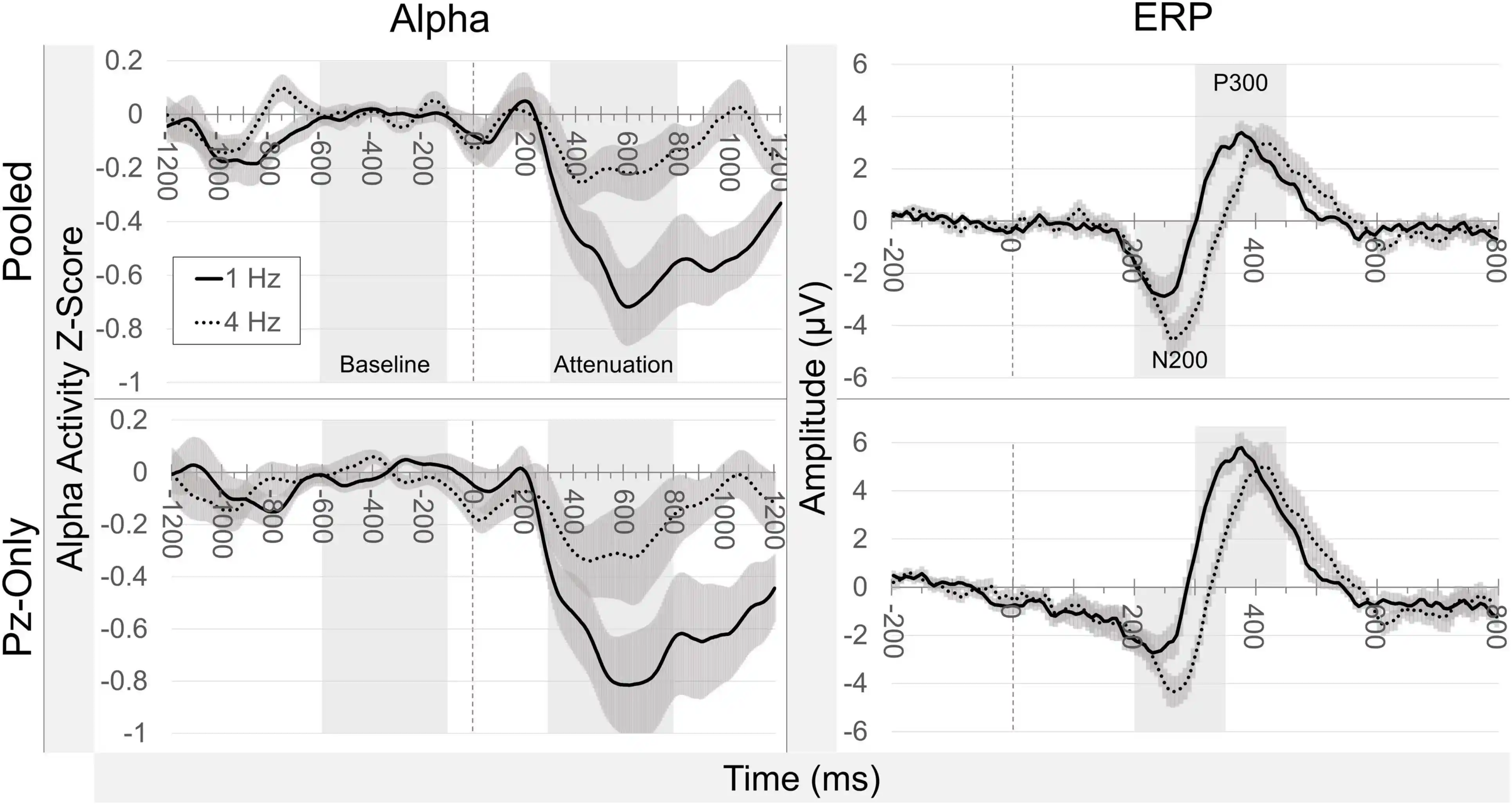 Target-related alpha attenuation in a brain-computer interface rapid serial visual presentation calibrationPublishedDaniel Klee, Tab Memmott, Niklas Smedemark-Margulies, and 3 more authorsFrontiers in Human Neuroscience, 2022
Target-related alpha attenuation in a brain-computer interface rapid serial visual presentation calibrationPublishedDaniel Klee, Tab Memmott, Niklas Smedemark-Margulies, and 3 more authorsFrontiers in Human Neuroscience, 2022This study evaluated the feasibility of using occipitoparietal alpha activity to drive target/non-target classification in a brain-computer interface (BCI) for communication. EEG data were collected from 12 participants who completed BCI Rapid Serial Visual Presentation (RSVP) calibrations at two different presentation rates: 1 and 4 Hz. Attention-related changes in posterior alpha activity were compared to two event-related potentials (ERPs): N200 and P300. Machine learning approaches evaluated target/non-target classification accuracy using alpha activity. Results indicated significant alpha attenuation following target letters at both 1 and 4 Hz presentation rates, though this effect was significantly reduced in the 4 Hz condition. Target-related alpha attenuation was not correlated with coincident N200 or P300 target effects. Classification using posterior alpha activity was above chance and benefitted from individualized tuning procedures. These findings suggest that target-related posterior alpha attenuation is detectable in a BCI RSVP calibration and that this signal could be leveraged in machine learning algorithms used for RSVP or comparable attention-based BCI paradigms.
2021
-
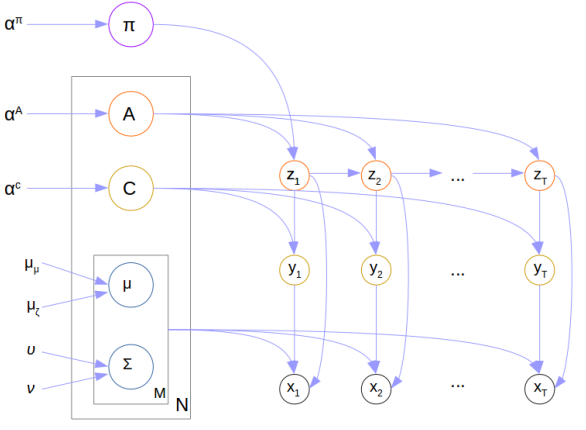 Variation is the norm: Brain state dynamics evoked by emotional video clipsPublished EMBCAshutosh Singh, Christiana Westlin, Hedwig Eisenbarth, and 7 more authorsIn 2021 43rd Annual International Conference of the IEEE Engineering in Medicine & Biology Society (EMBC), 2021
Variation is the norm: Brain state dynamics evoked by emotional video clipsPublished EMBCAshutosh Singh, Christiana Westlin, Hedwig Eisenbarth, and 7 more authorsIn 2021 43rd Annual International Conference of the IEEE Engineering in Medicine & Biology Society (EMBC), 2021For the last several decades, emotion research has attempted to identify a “biomarker” or consistent pattern of brain activity to characterize a single category of emotion (e.g., fear) that will remain consistent across all instances of that category, regardless of individual and context. In this study, we investigated variation rather than consistency during emotional experiences while people watched video clips chosen to evoke instances of specific emotion categories. Specifically, we developed a sequential probabilistic approach to model the temporal dynamics in a participant’s brain activity during video viewing. We characterized brain states during these clips as distinct state occupancy periods between state transitions in blood oxygen level dependent (BOLD) signal patterns. We found substantial variation in the state occupancy probability distributions across individuals watching the same video, supporting the hypothesis that when it comes to the brain correlates of emotional experience, variation may indeed be the norm.
